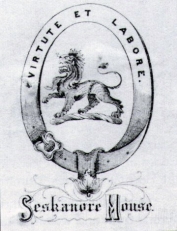Alex Watson is a researcher and genealogist, based in Glasgow, Scotland, I hope that you find this website informative, it is an ongoing project, based on the research that I started, in 2004, on behalf of my friend Patrick Joynson-Wreford, it will continue to be updated as more information becomes available.
Please get in touch if you want to ask questions or need some help, also if you have any information, stories, photographs, etc, that you want to share.
The Manor of Fentonagh
1607-10
John, Edmond and Daniel Leigh, three brothers, came to Ulster under the auspices of Sir Henry Bagenall. (Captain Edmond Leigh was appointed sheriff in 1607 of the fort of Omagh). Edmond died in 1608, the lands granted to the two remaining brothers were those that had belonged to the abbey of Omey which were not known as such by the surveyors of 1608 and 1609. Hence the allotment of these lands to undertakers. The Leighs stated, in a memorial, that "some parcels of their lands had, by the oversight of the King's Surveyors, been included in the grants to undertakers. which, however, they [the Leighs] were willing to resign, rather than disturb the said undertakers." The King was so impressed with this profession of readiness to suffer loss in the great plantation cause, that he ordered Chichester to re-grant to the Leighs all their other lands on their own terms. The undertakers who had thus got portions of the lands belonging to the Leighs were Sir John Davys, Sir Thomas Boyd, Mr. Clephane, George Hamilton, and the bishop of Derry.
Vol. 630, p. 112.
- A Brief Note of such Suits as John [and Daniel] Leigh, of the Fort Omagh, in the county of Tyrone, have to be Petitioners for unto the King.
- That the King will grant him his letters to the Lord Deputy for the command of the ward of the said fort which now they have, to be held by letters patent from the King during their lives and the longest liver of them, in consideration of their long service in those parts.
- That the King shall allow the said John Leigh a reason-able consideration for building the said fort, in regard it is made in a place of such strength and importance, for his service in those parts, that it is most meet it should be the King's and not a subject's. There hath been an estimate of the charge for building thereof already certified to their Lordships by the Deputy, by which the King will save at the least 1,000 marks English. It is estimated at £800 English by the Deputy when it is fully finished, and £200 will not finish what is yet intended to be done to it, and the finishing thereof is at this instant in doing. It is desired that £250 be now paid towards the great charge it hath cost. And for the rest we will be content to receive payment in Ireland out of the King's rents in the north, or otherwise as it shall please the Deputy to appoint the Lo. Treasurer to make payment for it.
- That the King will be pleased to authorise the Lo. Deputy to assign the said John Leigh such valuable quantity of the land in Tyrone lately escheated as in his discretion shall be thought fit, in exchange for so much of the said John Leigh's land next adjoining the fort as shall be thought meet by his Lordship to be annexed for ever to the said fort for the use and benefit of the constable and the wards thereof after the decease of the said John Leigh and his brother Daniel Leigh.
- The said John Leigh makes further suit, that in regard of the remoteness of that fort from other places of succour for travellers, if is thereby a place of very extra-ordinary charge in receiving and giving entertainment daily unto all men of quality who pass to and fro that way; and, besides, divers times in the year, both the judges of assize who ride that circuit, and other Commissioners sent upon occasion of the King's service unto those parts, are by him entertained and lodged. In consideration whereof it may please the King to allow the commander of that fort five shillings English by the day for himself, he having none but three shillings English, which is a very small allowance for a place of such daily charge. This, if it please your Lordships to consider, will, it is hoped, be thought very reasonable both in regard of the petitioner's desert and his brothers, for their long service, and also for the great charge they live at there. Lastly, as in a place of such importance there is yet neither a porter nor a canonnier allowed, the King may be likewise pleased, both for the better enablement and safety of that place, to give allowance for them at such rates of entertainment as they usually have in the King's other forts in that kingdom, of like strength and importance.
Copy. P. 1.
Calendar of the state papers, relating to Ireland, of the reign of James I. 1603-1625.
In 1610, John Leigh was granted 2000 acres to be erected into the manor of Fentonagh, in the Precinct of Clogher.
- Grant to John Leigh (28), gent. The large proportion of Fentonagh (29), containing
Leggetiggill, one balliboe; Ballinemullan, one balliboe; Killelussie, one balliboe; Townagheitra,
one balliboe; Shragduffgawra, one balliboe; Garowry, one balliboe; Ballineskelgie, one balliboe;
Tooughgorrhan, one balliboe; Edentooderry, one balliboe; Lackaboy, one balliboe; Tiregrenan,
one balliboe; Tonnoghonewe, one balliboe; Tatmoyle, one balliboe; Correceskan, one balliboe;
Syonhugh, one balliboe; Tollenshee, one balliboe; Corbally, one balliboe; Drumhurke, one
balliboe; Shraghmaske, one balliboe; Mullasilloge, one balliboe; Kilberry, one balliboe;
Dromlaghan, one balliboe; Skegagowre, one balliboe; Derriaghna, one balliboe; Mullanedrymon, one balliboe; Ardtonny, one balliboe; Aghebrassill, one balliboe; Tatfadda, one balliboe; Townaghbane, one balliboe Ravarran, one balliboe; Edenesoppe, one balliboe; Lissnegorduffe, one balliboe; Tatecrewe, one balliboe; 1/5 of the balliboe of Gargrame; and Corglasse, one balliboe; in all, 2,000 acres. Rent, £10. 13s. 4d. English.
The premises erected into the manor of Fentonagh, With 600 acres in demesne, and a court baron. To hold forever, as of the castle of Dublin, in common socage [1610].
See Inquisitions of Ulster, Tyrone (38) Car. l.
(28). John Leigh.- This gentleman was one of three brothers well known in connection with the history of that period in Ulster, or strictly speaking in Tyrone. He must have purchased this proportion from Sir Francis Willoughby at an early date, as the latter had Possession probably before he had got out a patent. Willoughby was one of the earliest undertakers to get his
patent.
(29). Fentonagh.- This proportion occupies on the map the whole north-western corner of the barony or precinct of Clogher. Its Shape is distinctly triangular; and its surface appears unencumbered alike with wood or bog. There are discrepancies in the spelling of several denominational names in the above grant, as they appear on the map and in the inquisition from which we have quoted. The time that had elapsed between 1609 and the 38th of Charles l. may have introduced most of these orthographical varieties.
Hill, G. (2004). Names in the Land Grants in Northern Ireland: From the Plantation of Ulster. United States: Irish Genealogical Foundation.
1610, Undertakers allotted as part of the Plantation of Ireland:
To the Commissioners for the plantation of the Escheated (confiscated) Lands in Ulster.
(b) Precinct of Clogher (Co. Tyrone).
The Assignation of the landes of the Precincte of Clogher, made
unto several undertakers by the right honourable the Lord Audeley, to
whome the orderinge of that Precincte is allotted.
|
Sir Thomas Ridgeway |
Portclare & Ballykeirgire |
2000 |
|
Thomas Roche of Essex Esq. |
Ballmecowley & Balliranell |
2000 |
|
Mr. Francis Willoughby Son to |
Fentonaghe |
2000 |
|
George Ridgwaie |
Ballimackell |
1000 |
|
William Parsones Survaior |
Ballaclogh |
1000 |
|
Wm Orley gent |
Dirribard & Killarie |
2000 |
|
Capt Edney & his brother Thomas Edney |
Loughmaguiff |
1500 |
|
William Turvyne gent |
Moyenner |
1000 |
[sic]
30 Aprilis 1610
I have made choise of the persons above named, whom I thinke
to be of sufficient abilitie to undertake the said severall quantities of
land, which I desire the Commissioners for the plantation to see indifferently
sett out, soe as evrie of them maie take his portion by lott or agreement.
Theis are to require you to make several particulers in due forme
of the proportions above written for the several persons above named,
Incerting in the particular made for Sir Thomas Ridgway, the Advowson of the
Church, wherein the proportion assigned to him or the greatest
Parte thereof lieth with the rente answerable for evrie proportion
By the Articles of Plantation, excepting the gleabe lands which are
To be allotted to the Incumbentes with such other circumstances,
As are fit to be remembered touching the same. And to ingrosse
it in parchment under your hand, to be sent to the Commissioners for Irishe
causes, to thend it maie be examined by them, and after dellivred
unto us, that thereupon direcon maie be geven for pasinge of the same
by Ires pattentes accordingly.
Signed by the earle of Salisbury.
[sic]
Moody, T. (1938). Ulster Plantation Papers. Analecta Hibernica, (8), 179-297. Retrieved February 3, 2021, from http://www.jstor.org/stable/25510951
Rev. George Hill writes in the 'Plantation Papers: Containing a summary sketch of the Great Ulster Plantation in the year 1610' 'The Commissioners found in this barony or precinct of Clogher only 12,500 acres or arable land, which they marked off into ten proportions - seven small, one middle, and two great. These proportions were soon afterwards allotted to the following eight English undertakers, viz:-
Sir Thomas Ridgeway, Knight; John Leigh, gentleman; Walter and Thomas Edney, Esqrs.; George Ridgeway, gentleman; William parsons, Esq.; William Turvin gentleman; Edward Kingswell.; and William Glegge, gentleman.'
Hill then goes on to write that:-
'When the above named planters had been in possession of their several estates in Clogher for a year, Sir George Carew made the following report 'Sir Francis Willoughby, Knight [who sold out to John Leigh], 2000 acres; has taken possession personally'.
'John Leigh was an engineer by profession, and came to Ulster with the Earl of Essex in 1571. Before the time of the Plantation he had visited many localities in this province as an engineer, and knew many of its leading Irish inhabitants. he appears to have bought the proportion of Fintona from Sir Francis Willoughby even before the latter had taken out a patent, for the grant was made in Leigh's own name.'
Hill, G., Northern whig. (1889). Plantation papers: containing a summary sketch of the great Ulster plantation in the year 1610. Belfast.

17th Century Barony Maps c.1609 - The Baronie of the Omey.
(From collection of maps of escheated counties of Ireland)
PRONI Ref: T1652/17
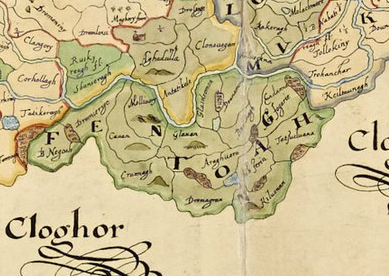
1) The Manor of Fentonagh contained an alleged 2,000 acres (in fact it exceeded many times this extent) in the southern part of the parish (barony Of Clogher). John Leigh, an English adventurer, who served in Elizabeth's wars against the Irish, bought this estate from the first grantee, Sir Francis Willoughby.
Leigh, by 1619, had built here "a bawn of lyme and stone, with two flankers; and a good, large stone house within it, in which he dwelleth” (57). This was evidently the first Plantation house at
Castletown. erected on the old O'Neill site.
The English surveyor of the Ulster Plantation, Captain Pynnar, saw the beginnings of the new Fintona here in 1619, when he states that "near unto this (i.e. John Leigh's) bawn there is a small village consisting of eight houses” (58). It already had a total of forty-one British families settled here then. Twenty-one Of them were cottagers and Pynnar adds that "Each of these has a house and garden plot, most of them two acres, besides commons for cattle" (59).
A survey of 1622 describes some additions to Leigh's new home since Pynnar's visit:
A good dwelling house of stone, wherein himself (Leigh) and his familie inhabite. About it there is a bawne of stone and lyme, 93 foot square, 12 foot high, With three flanckers and a good gate to the said bawne. There is a base court enclosed with a rampart of sods before his house” (60).
(57). 265, 543. Re frauds in the Ulster Plantation, cf. Hill, op. Cit., passim, e.g. 'This large precinct or barony (of Omagh) contains no less than 224,674 acres, and it was handed over to five undertakers, who are represented as having had only 11,000 acres distributed amongst them all!" (p. 268, note 43).
(58). Ibid, 543.
(59). Ibid, 544.
(60). Treadwell, “The Survey of Armagh and Tyrone, 1622”, UJA (1964), 156.
Gallachair, P. (1970). The Parish of Donaghcavey. Clogher Record, 7(2), 251-320. doi:10.2307/27695649
The Leigh Baronetcy of Tyrone was established in the Baronetage of Ireland in February 1622, granted to Sir Daniel Leigh.
The title became extinct upon the death of his only son and successor, Sir Arthur Leigh, in 1638. The family was connected by marriage and property to notable Irish and English families including the Ryves, Arundells, Crompton, and Bingly (Bingly), and involved in various legal disputes and Civil War-era petitions.
Timeline with Key Individuals and Sources
1604
-
1 April: Grant by Sir Ralph Bingley to John Leigh of his manor in Co. Donegal.
Source: Betham’s Transcripts (Genealogical Office, Dublin)
c.1610
-
Marriage of Sir Daniel Leigh to Mary Stanton (daughter of John Stanton).
Inferred from children's birthdates and family petitions
Unknown Dates
-
Births of Arthur Leigh (son of Sir Daniel & Mary) and Mary Leigh (daughter, later married George Arundell).
Inferred from records of marriage and inheritance
20 February 1631
-
Death of John Leigh, brother of Sir Daniel Leigh. Administration granted to Ellis Crompton. Sir Daniel inherits the manor of Fentonagh (also called Castleleigh).
Source: Betham’s Transcripts
6 August 1632
-
Regrant of Fentonagh lands (Castleleigh) confirmed by Letters Patent to John Leigh.
Source: Patent Rolls, Chancery, Ireland
1 February 1633
-
Death of Sir Daniel Leigh. Administration of his estate granted to his son, Arthur Leigh, Bart.
Source: Betham’s Transcripts; Probate Calendar
27 February 1635
-
Death of Sir Arthur Leigh, 2nd Baronet of Fentonagh, without issue. Wife was Lady Elizabeth Ryves.
Source: Betham’s Transcripts; Ryves Family Will Abstracts
c.1636
-
Widow Dame Mary Leigh (widow of Sir Daniel) marries Captain John Bingly.
Inferred from subsequent petitions and records
19/27 September 1638
-
Marriage of Elizabeth Leigh (widow of Arthur Leigh) to John Bingley Esq. of Dublin.
Source: Betham’s Transcripts
Easter Term 1640
-
Chancery Bill by Thomas Newburgh vs Dame Mary Lee, George Arundell, John Cheswise, and Edward Baker.
Source: Chancery Bills, Ireland
c.1642
-
Death of Captain John Bingly (2nd husband of Dame Mary Leigh), serving in Col. William Cromwell’s Regiment.
Source: Petition of Dame Mary Leigh, 1646
c.1642–1645
-
Marriage of Dame Mary Leigh/Bingly to Captain John Cheswis of Nantwich, Cheshire.
Source: Civil War pay records; Chancery Bills
2 October 1645
-
Record of partial payment to Lady Leigh for arrears due from Captain Cheswis, slain in Parliament's service.
Source: Parliamentary Army Pay Orders, UK National Archives
23 December 1646
-
Petition of Dame Mary Leigh, widow of Captain John Bingly. Claims £4000+ owed and lost income from Rathsallagh (Wicklow) and £250/yr rent from Fentonagh (Tyrone).
Source: Parliamentary Petitions, TNA: SP 23/179/28
10 March 1647
-
Death of Sir William Ryves (father of Lady Elizabeth Leigh), nuncupative will names daughter Elizabeth Leigh.
Source: The Reeves Project: Ryves RR20ID18; TNA Probate Records
c.1654
-
Death of John Bingley Esq. of Dublin, widower of Elizabeth Leigh. She remarries Alderman William Smith of Dublin.
Source: Chancery Bills; Dublin Probate Calendar
1654–1656
-
Civil Survey of Ireland: mentions Alderman Smith and Lady Leigh (Elizabeth) holding lands in Tyrone.
Source: Civil Survey Vol. 3: County Tyrone
20 January 1658
-
Death of Dame Mary Cheshwis, formerly Dame Mary Leigh. Betham records her as relict of John Cheshwis and of Sir Daniel Leigh. Mentions granddaughter Anne (Arundell) Fitch.
Source: Betham’s Transcripts; PRONI D1960/4/19
1662, 20 October
-
Administration of John Bingley Esq. of Dublin granted to daughter Dorothea Bingley.
Source: Dublin Consistorial Court Records
c.1668
-
Mary Leigh’s marriage to James Chadwick recorded in Sparrow v Chadwick suit concerning Leigh estate in Tyrone & Down.
Source: TNA: C 7/323/18
21 May 1670
-
Administration of Elizabeth Leigh/Bingley granted to daughter Dorothea Meredith (née Bingley).
Source: Dublin Probate Court; Chancery Bills
14 October 1670
-
Lease to Arthur Meredith references £220 annuity due on Lady Elizabeth Leigh’s estate from the Duke of Ormond.
Source: PRONI T2125/12/4
30–31 May 1671
-
Sale of Fintona Manor by Arthur & Dorothea Meredith to Gilbert Eccles.
Source: PRONI D526/1, T962/1
2 August 1675
-
Alderman William Smith (former husband of Elizabeth Leigh) elected Mayor of Dublin.
Source: Monday Books, Dublin City Council Archives
8 November 1684
-
Alderman John Smith replaces William Smith as JP, confirming William Smith’s death.
Source: Monday Books, Dublin City Council Archives
Key Persons
Sir Daniel Leigh, 1st Baronet
-
Married Mary Stanton; father of Arthur (2nd Bart) and Mary (m. George Arundell)
-
Created baronet in 1622, died c.1633
Arthur Leigh, 2nd Baronet
-
Married Elizabeth Ryves; died without issue 1635
Dame Mary Leigh
-
Widow of Sir Daniel Leigh; later married Captain John Bingly, then Captain John Cheswis, and then James Chadwick
-
Active petitioner during Civil War
-
Died c.1658
Elizabeth Ryves / Leigh / Bingley / Smith
-
Daughter of Sir William Ryves
-
Widow of Sir Arthur Leigh, then married John Bingley Esq., then Ald. William Smith
Dorothea Bingley / Meredith
-
Daughter of John Bingley Esq. and Elizabeth Leigh
-
Married Arthur Meredith; involved in the sale of Leigh lands
George Arundell
-
Married Mary Leigh (daughter of Sir Daniel); father of Anne Arundell (m. Edward Fitch)
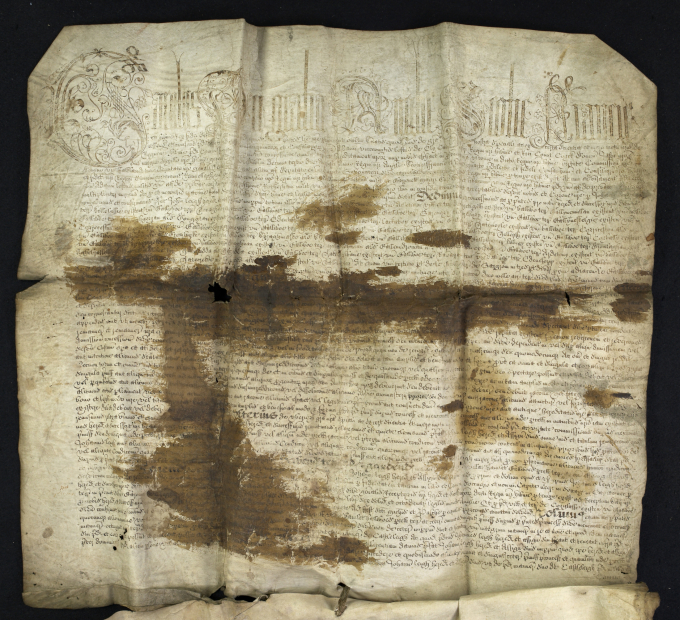
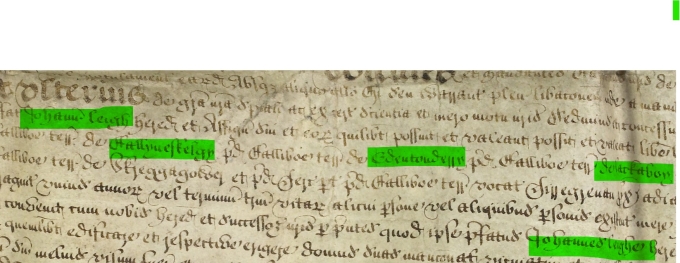
Above; Names of some of the Balliboes are clear.
Below; 'Johannes Leigh' and 'CastleLeigh'

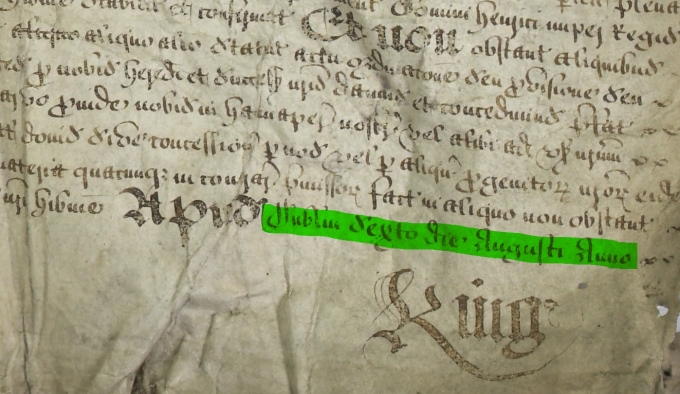
Sir John Bingley, Knt
28 March 1638, 17 Nov/d
Wife Elizabeth
only son John
daur Flower
gdson John Bingley son of John
5th Dec 1639
This assurance is taken
in Y hand of me Sir Wm.
Ryves to Y use of the
La: Grey also Bingley &
of my Sonn in Law John
Bingley and Dame Eliz
abeth his wife according
to the certain articles of
agreement made between
Ye Dame Lady Grey and
John Bingley of Y one part
and Y said Sir Wm Ryves
of Y other part on
Y Intermarriage of the
said John Bingley and Y said
Dame Elizabeth
Y Testator
Wm Ryves
|
PARISH of DONOCAVIE CHURCH LANDS of YE SEE of CLOGHER |
|||||
|
Name of the Leasee &c |
Denomination of land |
Number of Acres &c |
Land Profittable |
Land Unprofittable |
Bpps rent in Anno 1640 |
|
Alderman Smith of Dublin by his Lady, ye Lady Leigh English Protestant |
Rachearan Cummor Feinon Ravarron four towne lands |
Two hundred Acres
|
Meadow – 020 Arable – 120 Pasture - 010
|
Mountaine & Bogg - 050 |
12 : - : - |
|
Totall - |
|
200 Acres |
150 : - : - |
50 : - : - |
12 : - : - |
|
|
|||||
|
PART of ye PARISH of DONOCAVIE |
|||||
|
Name of the Proprietor &c |
Denomination of land |
Number of Acres &c |
Land Profittable |
Land Unprofittable |
Crowne rent in Anno 1640 |
|
Willm Smith Alderman of Dublin & the Lady Ley his wife English Protestants |
Toghafadda Lisnecrive Edentudrie Lackagh boy four towne land |
Two hundred & forty acres |
Arrable – 060 Pasture - 060 |
Barren/ 090 Mountaine Bogg - 030 |
02 : 13 : 04 |
|
Aghnabrissel Draughton Dongoran Scregagore Killaberrie Dromlaghin Tullarush Seanew in all eight towne lands |
Four hundred and thirtie acres |
Meadow – 024 Arable – 110 Pasture - 115 |
Mountaine - 100 Bogg 081 |
05 : 06 : 08 |
|
|
Tonnagh Terenan Mullasillago Corvelley Scrunick Tatewile Cariglas Corriesk in all eight towne lands |
Five hundred and fiftie five acres |
Meadow – 022 Arable – 120 Pasture - 113 |
Mountaine -190 Bogg -110 |
05 : 06 : 08 |
|
|
Tanaghitragh Skelgagh Killaliss Lagashegall Mullan Druman Ardatiny Stradagor Garvolly Gargrim in all nine towne lands & one third |
Five hundred and fifty seaven acres |
Meadow – 034 Arable – 161 Pasture - 138 |
Barren/ Mountaine - 097 Bogg - 030 |
06 : 04 : 05 |
|
|
Totall |
|
1682 Acres |
960 : - : - |
722 : - : - |
19 : 11 : 01 |
|
|
|||||
|
BARONY OF STRABANE THE PARRISH OF CAPPY |
|||||
|
Name of the proprietors & theire quallificacons [sic] |
Denomination of land |
Number of Acres by Estimate of ye Countrey |
Land profitable & the quantity of itt[sic] |
Land Unprofitable & waste |
Vallew of theise lands in the yeare 1640. |
|
The Heyrs of Sr. Daniell Liegh English Prottestantt [sic] |
Shirrygrum & Lissnammallogh by estimate one balliboe & one third being Abby land |
Sixty six - 66 |
Arable – 40 Pasture - 16 |
Bogg and mountayne - 10 |
08 – 00 - 00 |
|
Totall |
|
66 |
56 |
10 |
08 – 00 - 00 |
The Civil Survey A.D. 1654–56 counties of Donegal Londonderry and Tyrone vol. iii with the returns of church lands for the three counties, (10 vols 1931–61)
Eccles Family Settlement in Tyrone
During the reign of Charles II, the Eccles family settled in Fintona, County Tyrone, and quickly rose to prominence as one of the region's most established landed families. Their surname originates from the Barony of Eccles in Dumfriesshire, Scotland, which their ancestors held.
A direct descendant, John Eccles of Kildonan, Ayrshire, lived in the early 1600s. He had two sons:
-
John Eccles, a noted Royalist.
-
Gilbert Eccles, who migrated to Ireland during the reign of Charles I (1625–1649).
Gilbert Eccles purchased several manors in Counties Tyrone and Fermanagh, including lands originally held under Letters Patent granted to John Leigh on 6 August 1632—these lands included the manor of Fentonagh/Castleleigh, previously associated with Sir Daniel Leigh, 1st Baronet of Tyrone.
Gilbert Eccles died on 26 July 1694 at the age of 92, and was buried at Castletown Graveyard, Fintona. His eldest son, Charles Eccles, inherited the Tyrone properties, serving as High Sheriff of Tyrone in 1694. In 1703, Charles built Ecclesville House, Fintona. His son, Daniel Eccles, succeeded him.
Source: Obituary of Charles Eccles, Esq., J.P., D.L., 1869 (preserved in local histories and gravestone memorials, Castletown graveyard, Fintona).
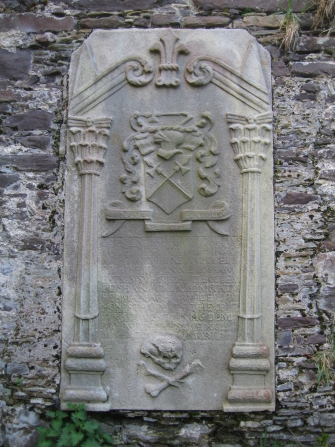
The above memorial reads;
'This cenotaph Charles / Eccles of Fintonagh in Co / Tyrone, Gentleman /, had made in memory / of his father, Gilbert Eccles of Shanock in Co. / Fermanagh, Gentleman, who / honourably lived and dutifully died / on the 6th of the Kalends of August, in the year of the Lord 1694, in the 92nd year of his age. / Remember Death'
Gallachair, P. (1970). The Parish of Donaghcavey. Clogher Record, 7(2), 251-320. doi:10.2307/27695649
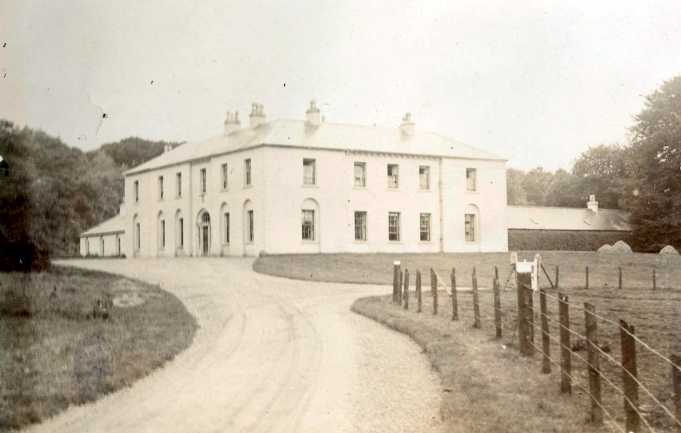
Ecclesville House, 1914.
Above picture is from a scrap book of Raymond Browne-Lecky's deposited at PRONI, D1385/4.
Eccles Family Genealogy – Ireland Branch
I. John Eccles of Kildonan, Ayrshire
-
Active: Living in 1618
-
Married: Janet Cathcart, daughter of John Cathcart of Carleton and Helen Wallace
-
Children:
-
John Eccles (senior line, remained in Scotland)
-
Gilbert Eccles (younger son; migrated to Ireland)
-
II. Gilbert Eccles (1602–1694)
-
Born: 1602
-
Died: 26 July 1694, aged 92
-
Settled in Ireland: During the reign of Charles II (1660–1685).
-
Acquired Estates: Counties Fermanagh and Tyrone (including Fintona/Castleleigh)
-
Sheriff:
-
High Sheriff of Fermanagh in 1665
-
High Sheriff of Tyrone in 1673
-
-
Married: Ann Cockburn
-
Issue (at least three sons):
IIIa. Daniel Eccles of Shannock
-
High Sheriff of Fermanagh: 1675
-
Marriage: Sarah Moore, daughter of William Moore of Tullavin, Co. Cavan (articles dated March 1670)
-
Died: March 1688 (predeceased his father)
-
Issue: Three sons and five daughters
-
Note: Daniel died vita patris (dvp), so did not inherit
IIIb. Charles Eccles of Fintona, Co. Tyrone
-
Inherited Fintona estate (formerly Leigh baronetcy lands)
-
High Sheriff of Tyrone in 1694
-
Justice of the Peace under Queen Anne and George I
-
Inherited Fermanagh estates via will of his brother:
-
Joseph Eccles of Rathmoran, High Sheriff of Fermanagh in 1712
-
Joseph’s Will: Dated 3 August 1709, proved 17 September 1723, left estates to Charles
-
-
Died Intestate: Administration granted 7 November 1726 to his son (name not yet supplied)
Connection to Leigh Baronetcy and Lands
-
Gilbert Eccles acquired the manor of Fintona/Castleleigh from Arthur Meredith and Dorothy (née Bingley), who inherited the Leigh estates from Dame Elizabeth Leigh (widow of Sir Arthur Leigh, d. 1638).
-
The Leigh lands were originally granted by Letters Patent to John Leigh on 6 August 1632.
-
Ecclesville (Fintona) was constructed by Charles Eccles in 1703 on former Leigh land, becoming the family seat.
Sources and Supporting Evidence
-
PRONI D526/1: 1671 deed – Arthur & Dorothy Meredith sell Leigh lands (Fintona) to Gilbert Eccles
-
Obituary of Charles Eccles, Esq., J.P., D.L., 1869: Ecclesville memorial history
-
PRONI T962/1, T2125/12/4: Eccles family wills, land deeds
-
Burke’s Landed Gentry of Ireland (19th–20th century editions)
-
PRONI Wills: Admin to Charles Eccles (1726); Joseph Eccles will (1709/1723)
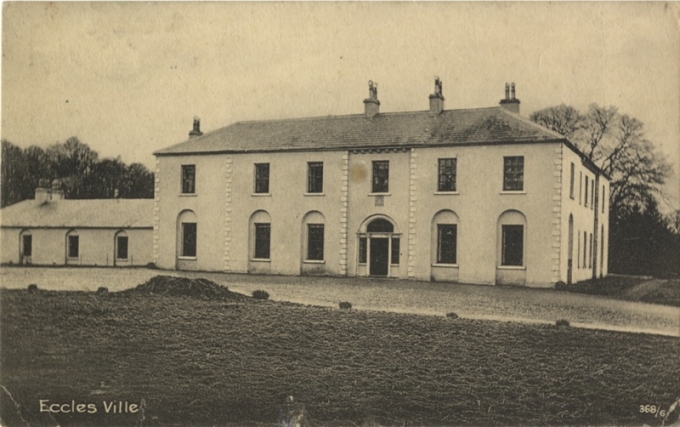
The original residence of the Leigh family, Baronets of Tyrone (created 1622), is no longer standing. It is believed to have stood on or near the site where Charles Eccles constructed a new residence, later known as Ecclesville House, around 1703. This marked the physical and symbolic transition of the estate from the Leigh baronets to the Eccles family, following the acquisition of Leigh lands by Charles Eccles c.1671–1700, after the extinction of the baronetcy.
When Ecclesville House was demolished in 1978, the datestone and Eccles coat of arms, originally mounted above the entrance, were preserved. These historic elements were later incorporated into the Ecclesville Equestrian Centre, which now occupies part of the former Ecclesville demesne, maintaining a tangible link to the 17th–18th century estate history of Fintona.
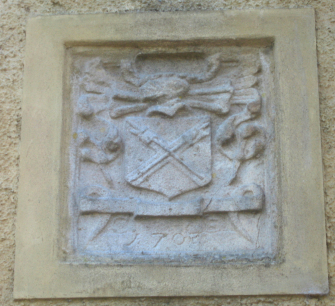
-
Gilbert Eccles of Fintona
Died 1694
Originally of the Scottish family of Eccles of Dumfriesshire; settled in Ireland during the Plantation period.
Established the Ecclesville estate at Fintona.
Issue:- Daniel Eccles – heir (see below)
. Daniel Eccles of Fintona
Born: 1692 Died: 1750 High Sheriff of Tyrone: 1720
Will: Dated 10 Nov 1747, proved 2 Jul 1750
Married (1718): Mary Lowry, daughter of Robert Lowry of Ahenis and Anna Sinclair of Holyhill
Issue:- Charles Eccles – heir (see 2)
- Robert Eccles – of Co. Fermanagh; m. Miss Boggs; d. 23 Apr 1753; had 2 sons & 6 daughters
- James Lowry Eccles – m. Miss Parry; had 2 sons & 2 daughters
- Mervyn Eccles – dsp
- Anne Eccles
- Frances Eccles – m. 1740 John Dickson of Ballyshannon, Co. Donegal
- Margaret Eccles – m. 17 Feb 1743, Robert or John Smyth (Cornet, HM 14th Dragoons); had issue
- Mary Eccles – m. Mr. Delamere; dsp
- Elizabeth Eccles – m. (1) Dr. Draydon; (2) 11 May 1750, Capt. Ley; dsp
- Isabella Eccles – m. Rev. Francis Lucas, Rector of Drumgoon; had issue
- Charles Eccles of Ecclesville
Died: 30 Dec 1763 High Sheriff of Tyrone: 1709
Married: Rebecca Anne Stewart of Bailieborough Castle (d. 26 Apr 1790)
Issue:
- Daniel Eccles – heir (see 3)
- John Eccles – dsp
- Rev. Charles Eccles – drowned at Bath
- Daniel Eccles of Ecclesville
Born: 1746 Died: 1808 Succeeded father: 1763 High Sheriff of Tyrone: 1772
Married (28 Feb 1773): Anne Dickson, daughter of John Dickson of Ballyshannon
Issue:
- Charles Eccles (b. 1777 – d. 15 Dec 1807) – High Sheriff 1802; dsp
- John Dickson Eccles – heir (see 4)
- Gilbert William Eccles (b. 4 Sep 1784) – dsp
- Daniel Eccles (b. 15 Mar 1787 – d. 1869)
- Thomas Eccles (b. 29 Jun 1791) – dsp
- James Eccles
- Frances Eccles (b. 7 Dec 1775) – m. cousin Charles Lucas
- Anna Rebecca Eccles (b. 13 Jun 1779) – unmarried
- Mary Eccles (b. 11 May 1781) – m. 3 Mar 1810, Rev. James Lowry Dickson (cousin)
- Elizabeth Letitia Sarah Eccles (b. 14 Jul 1786 – d. 27 Sep 1833) – m. 1813 William Newcombe
- Hester Eccles (b. 28 Apr 1789) – m. 1817 William Dickson; had issue
The Times
London, Middlesex, EnglandJune 14, 1843
TRAGICAL OCCURRENCE:- We regret to have to announce the death of the Rev. James Lowry DICKSON, rector of Lavey, county of Cavan, under the following melancholy circumstances:- It appears that on Wednesday last Mr. DICKSON, having returned home from Cavan, felt somewhat fatigued, and after dinner retired to bed. Mrs. DICKSON being out visiting at the time, there was no person in the house but the servant maid and a person named ECCLES, a relative of Mrs. DICKSON, who unfortunately is subject at intervals to fits of mental derangement. This person having entered the dining-room after Mr. DICKSON had retired, and having partaken copiously of a decanter of spirits, which he found on the sideboard, commenced smashing the glasses, &q., when the servant maid, although well aware of the danger she incurred by interfering, came to the door and forbade him to act in such a manner, whereupon he pursued her upstairs, whither she fled to one of the bed-rooms for refuge. On reaching the lobby, the maniac darted into Mr. DICKSON'S room, who was then in a profound sleep - alas! a "sleep that was to know no waking" - and having seized a razor which lay upon the dressing-table, with one stroke of (ineligible) weapon completely cut the trachea, by which respiration was instantaneously suspended, and the vital spark extinguished. An inquest was held on the body on Thursday, where a verdict in accordance with the foregoing circumstances was returned.
The Times
London, Middlesex, EnglandJune 15, 1843
ATROCIOUS FABRICATION:- The following appeared in the Mail of
last night:- “In the Mail of Monday we gave a circumstantial account of
the murder of the Rev. James Lowry Dickson, rector of Lavy [sic], in the
county of Cavan, alleged to have taken place by the hand of a maniac,
while in a state of furious excitement, produced by intoxication. That
statement and the finding of the inquest we gave on the reputed authority of
a person who represented himself in his letter as the coroner of the county,
and we inserted it without entertaining a doubt of its correctness: for we
could not have imagined depravity or harshness to exist to invent so
atrocious a story. The whole statement is a villainous fabrication: and
fortunately, having preserved the original manuscript, which we have
given to a near connexion of Mr. Dickson. by whom it will be forwarded
to the country by the night’s post, we are not without hope that the miscreant
will yet be detected. With the view of increasing the chances of such
a discovery, we hereby offer a reward of 20/. to any person who will
afford evidence substantially establishing
the guilt of the writer.”
- John Dickson Eccles of Ecclesville, JP
Born: 22 Sep 1783 Died: 12 Oct 1830 Succeeded father: 1808
Married (30 Oct 1810): Jemima Dickson, 3rd daughter of Thomas Dickson of Woodville, Co. Leitrim (d. 19 Apr 1879)
Issue:
- Daniel Eccles – dsp
- Charles Eccles – heir (see 5)
- Thomas Dickson Eccles (b. 3 Aug 1818 – d. Dec 1848) – dsp
- John Eccles (b. 20 Aug 1821 – d. 1845) – dsp
- James William Eccles (b. 14 Apr 1824 – d. Feb 1853) – dsp
- Rev. Robert Gilbert Eccles (b. 10 Jun 1826) – Rector of Kilbrogan; m. Nannie Dickson; had issue
- Hester Catharine Eccles (b. 26 Mar 1814 – d. unm. 7 Dec 1868)
- Anna Jemima Eccles (b. 21 Mar 1817 – d. unm. 17 Sep 1835)
- Eliza Frances Wilhelmina Eccles (b. 12 Jul 1829 – d. Jan 1865) – m. Rev. Benjamin Newcombe
ECCLESVILLE AND FINTONA.
When we visited Ecclesville in 1830, it was then the seat of the late lamented John Dickson Eccles, Esq. proprietor of the Fintona estate, and a country gentleman of sterling worth, though of plain and unassuming manners.
The demesne embraces about 250 acres of this property, lightly and ornamentally planted; but from its comparatively low position, it commands no prospect of the surrounding country; a fact in its topographic history, which need not be much lamented, since that country exhibits but little of the picturesque, and all that is necessary to a decent domestic landscape, may be found within the confines of Ecclesville demesne.
The house, which stands at a short distance from the public road, at the bottom of a valley formed by gently sloping hills, is a plain but noble edifice (the expressive type of the founder's honest mind, where the rich streams of benevolence, flowing through a retired valley to that invisible ocean, where they are now centred for ever, felt too deeply their own intrinsic worth, to court that sweet- smelling cowslip of popular applause, ‘which to-day is, and to-morrow is cast into the oven,’) and to this has been added all those plain and useful appendages of a family residence, which are necessary to decent rank and to substantial comfort.
Fintona, a market and post town on this estate (which has several shops, and does some business in the corn trade) may be regarded as the capital of the property. It stands on a public road a little elevated above the valley of Ecclesville, of which it commands an imperfect view; and although the appearance of this town is not remarkably attractive, we understand a good deal of business is done there; to which the policy of granting to improving tenants, leases in perpetuity, of houses and plots for building, must largely contribute; while a similar indulgence to persons of neither property nor talent, would mar the improvement of the town, and inflict a needless wound upon the interests of the landlord. To this admirable plan of giving the tenant a perpetual interest in his town holding, we would recommend (in every possible case) the addition of a few acres of land for the accommodation of his town establishment. This land, being held at a moderate rent on a lease of lives or years, would have a favourable influence on the interests of the whole estate, as the value of farms approximating with it would advance in an exact ratio with the wealth and population of the neighbouring town; and we hope this also is the policy of the Eccles family.
The valley of Ecclesville is separated from the town of Fintona by a water called the Casheron river, which passes through the Fintona estate. On this a corn mill has been erected for the accommodation of the tenantry, and a site for another mill with a fall of from seven to ten feet is said to exist upon the same river, and of course presents to some enterprising man of business, an inducement to form a bleaching or manufacturing establishment at that place. If the successors of the late Mr. Eccles follow his example, we have no doubt they will be found ready to give all due encouragement to this and every other instrument of employment to the poor that may be found to exist in their immediate neighbourhood; for from all that we could learn of the character of that lamented gentleman, as a landlord, a magistrate, and a man, his sudden removal by death, while we were travelling in his native county, was felt to be a public loss; and as such was very justly and generally deplored, by the poor and by the public.
'Ireland in the Nineteenth Century, and Seventh of England's Dominion: Enriched with Copious Descriptions of the Resources of the Soil, and Seats and Scenery of the North West District'
By A. Atkinson. Esq.
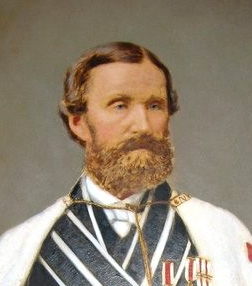
CHARLES ECCLES, of Ecclesville, JP and DL, High Sheriff 1835; b. 9 April, 1813; m. 9 April, 1840, Isabella, daughter of Edward Blake, JP and DL of Castle Grove, Co Galway, and by her, (who d. 30 Dec 1859) had issue,
DINNER TO CHARLES ECCLES, ESQ.
(From a Correspondent.)
Londonderry Sentinel - Saturday 31 May 1834
On Wednesday, the 14th inst., a number of the tenantry of the Ecclesville estate entertained their esteemed landlord, Charles Eccles, Esq., at Sherard’s Hotel. At six o’clock about sat down to a plentiful dinner, served up in a style highly creditable to Mrs. Sherard—the wines were excellent, and the "mountain dew” could not excelled. The chair was taken Charles Robert Lucas, Esq., supported by James Hamilton, Esq., who acted croupier. the cloth being removed the following toasts were given:—
“The King, God bless him, may still be found to reign in the hearts of his people.”—(Drank with the usual honour.)
The chairman now desired the company fill their glasses. He said, as they had met for a particular purpose, he would not occupy their time by going through the list of toasts generally drank at public dinners, nor would be detain them by pronouncing a panegyric the gentleman whose health he was about to propose; was well known to them all, and would, therefore, without further comment, give “Charles Eccles, Esq., may he follow the example of his late father.”— (Loud and long continued cheering.)
Mr. Eccles returned thanks in an animated speech, of which the following is a faint outline.—He said that the marks they had given of the warmth of their friendship, not only on this but on former occasion, had made an indelible impression on his heart, and imparted home a charm which no other place could possess. When I look, said he, around me, and see myself surrounded by such a numerous and respectable body of friends and neighbours, and including many of own tenantry, I feel a glow of lofty and laudable ambition animate my bosom, for who, let me ask, would not be proud of having such a spirited and truly independent tenantry. However, when I reflect that these flattering tokens of your esteem have not been earned by me, but by one of whom it would not be my place to speak here, a feeling of gratitude awakens in my breast emotions I cannot find words to express. (Applause.) l am now come to reside among you and, being young and inexperienced in the world, what a gratifying prospect it is for me to find that I have the open and honest-hearted friends of my lamented father to assist me by their kind advice. (Applause.) The old maxim, "live and let live,” has long been the motto of the family to which I have the honour to belong, and on this principle I shall also endeavour to act. The town of Fintona has improved rapidly within the last few years—to encourage this spirit, and promote the welfare of my tenantry at large, is a duty which I trust you will find me using every possible effort to perform, so that the bond of union which has hitherto existed between landlord and tenant on the lands I possess may pass out of my hands in the same unbroken, mutual, and indissoluble chain. Mr. Eccles sat down amid loud and reiterated cheers.
- Charles Eccles of Ecclesville, JP and DL
Born 9 April 1813 – Died 4 Nov 1869
High Sheriff of Tyrone, 1835
Married 9 April 1840, Isabella Blake, daughter of Edward Blake, JP and DL, of Castle Grove, Co. Galway (she d. 30 Dec 1859)
Issue:
- John Stuart Eccles – heir (see below)
- Capt. Charles Edward Eccles (b. 20 Oct 1850 – d. 1897) – m. 11 Dec 1883, Mathilda Theodosia Browne (daughter of Thomas Richardson Browne & Sarah de Montmorency); dsp
- Robert Gilbert Eccles (b. 25 Oct 1854 – d. young)
- Annie Henrietta Eccles (b. 25 Jan 1849) – m. Connolly William Browne Lecky (3rd son of T.R. Browne & Sarah de Montmorency); had issue:
- Raymond Saville Connolly de Montmorency Lecky Browne-Lecky (b. 17 May 1881 – d. 11 Nov 1961; dsp)
- Isabella Caroline Annie Browne-Lecky (b. 21 Sep 1879) – m. 1910 Charles Ernest William Bland of Stretton House; had issue:
- Patricia Ernest de Montmorency Bland (b. 24 Apr 1915) – m. Thomas Oliver Neville Clarke; had:
- Susan P. Neville Clarke, b. 10 Jan 1941
- Gertrude Marian Eccles (b. 9 June 1852 – d. in infancy)
- Constance Isabella Eccles (b. 8 Oct 1856) – m. Capt. James Vesey Lendrum (Seaforth Highlanders); had issue (1 son)
DEATH OF CHARLES ECCLES, ESQ., D.L. (4th November 1869)
It has never been our lot to discharge a more painful duty than to record the death of Charles Eccles, Esq., J. P., D.L., which took place at Ecclesville, on Thursday, the 4th inst., after a lengthened and distressing illness. The announcement some months ago, that he had become prostrated by disease, and that the medical gentlemen attending him entertained no hope of his recovery, was received throughout this county with the deepest regret, and although his was not a case in which the public could be said to have found any grounds for hoping against hope, the report of his death seemed in the end to carry with it the bitterness of a loss to which they bad not yet been reconciled, while it produced in many breasts a sensation to which only the death of some actually beloved one can give rise. We shall not say that Mr. Eccles was esteemed in this neighbourhood—he was more; the word which we have already used is a preferable one—he was beloved, beloved by his family, his friends, his tenantry, by every one who had an opportunity of knowing his worth.
Recap: Marriages Between the Eccles and Browne–de Montmorency Families
There were three marriages arranged between the children of Charles Eccles, JP and DL, of Ecclesville, County Tyrone, and his wife Isabella Blake (daughter of Edward Blake of Castle Grove, County Galway), and the children of Thomas Richardson Browne and Sarah de Montmorency of Aughentaine Castle, County Tyrone.
-
John Stuart Eccles married Frances Caroline Browne, daughter of Thomas Richardson Browne and Sarah de Montmorency.
-
Captain Charles Edward Eccles married Mathilda Theodosia Browne, another daughter of Thomas Richardson Browne and Sarah de Montmorency.
-
Annie Henrietta Eccles married Connolly William Browne Lecky, third son of Thomas Richardson Browne and Sarah de Montmorency.
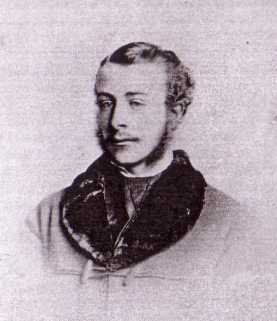
- John Stuart Eccles of Ecclesville (above)
Married Frances Caroline Browne, daughter of Thomas Richardson Browne & Sarah de Montmorency
Issue:
- Charles Raymond Eccles (b. 22 Aug – d. 4 Sept 1872)
- Amy Henrietta Frances Eccles (b. 22 Apr 1874 – d. 4 Apr 1942) – Held the Ecclesville estate as life tenant and beneficial heir under her father John Stuart Eccles’s will.
- Married 1893, John Knox McClintock of Seskinore, Co. Tyrone (d. 24 Oct 1936)
- Had issue:
- Amelia (Leila) Isobel Eccles McClintock (b. 21 July 1898 – d. 30 Jan 1937)
- m.1) Cecil Rhodes Field (divorced)
- m.2) 30 Aug 1932, Capt. Wilfred Heyman Joynson Wreford (b. 30 July 1896 – d. 23 Mar 1940), had issue:
- Penelope (Xenia) Joynson-Wreford (b. 3 Aug 1935)
- Rose Isabel de Montmorency Eccles (b. 5 Jan 1876) – m. 19 Dec 1906, Capt. Carfrae Hamilton Delmege (21st Lancers; d. 8 May 1929)
- Had issue:
- Anthony Charles Stuart Delmege – Heir to Ecclesville estate under the entailed terms of his grandfather John Stuart Eccles’s will.
- James Christopher Delmege (b. 1912)
- Sheelagh Edith Delmege (b. 10 Feb 1914 – m. 1) John William Wilder (d. 1934); 2) Richard James Kay Fenton of Dutton Manor & Clegg Hall; d. 28 Apr 2005; had issue)
- Anna Theodosia Hester Eccles (b. 8 Feb 1878) – m. Jan 1900, Capt. Leigh Sadleir Stoney (JP, 4th Royal Irish Fusiliers)
- Had issue:
- Rose Kathleen Rachel Stoney (b. 10 Oct 1900 – m. William Frank Sugden of Manchester; d. 17 Sept 1973)
- Issue:
- Theodore William Stuart – dsp
- Francis – dsp
Charles Eccles leased the lands of Castletown from The Ecclesiastical Commissioners for Ireland from 1st November 1868 for 21 years at the yearly rent of £6:9:3. Charles Eccles died in 1869 and in 1870, his son, John Stuart Eccles reached an agreement to buy them in fee simple for £439:7:9 with an annual of £41:10:9, this was followed with the purchase of Dundivin Glebe in 1876.
Joseph Taylor's Sales.
COUNTY TYRONE
IMPORTANT SALE
HORSES, AND CATTLE.
I HAVE been directed Mrs Eccles, of Ecclesville, Fintona,
who is leaving Ireland for the Winter, to Sell by Public
Auction, at the hour of Eleven o'clock, am, on Tuesday,
10th October, 1886, in the
FARMYARD, ECCLESVILLE,
THE FOLLOWING:
- 'Marigold,’ thorough-bred brood mare, 10 yearsold, got by Forester, with foal at foot by Forlorn Hope, served this season Strathardle.
- 'Colleen,’ brown filly. 3 years old, from Marigold,by Forlorn Hope.
- 'Jack.’ brown colt, two years old, from Marigold, by Forlorn Hope.
- 'Good Luck,’ chestnut carriage mare, single or double harness. 16 hands, 5 years old.
- 'Ruby.’ chestnut carriage mare, single or double harness,16 hands, 4 years old.
- ’Kathleen,’ very handsome brown carriage mare, all harness, 15-2 hands, 6 years old.
- 'Gipsy.’ bay mare, all harness, 14 hands, 9 years old.
- 'Sea Queen,’ bay mare, all harness, 10 years old.
- 'Mermaid.' bay mare, double or single harness, 14 hands, 5 years old.
- 'Eily,’ bay mare (splendid saddle mare.) 14 hands. 4 years old.
- 'Rosina.' bay mare, good for saddle harness, 15 hands, 6 years old.
- 'Nannie,' bay mare, works in all harness, 15-2 hands, 4 years old.
- 'Midget.’ grey mare, saddle or harness, 15 hands, 10 years old.
- 'Butterfly,' bay filly, untrained, 2years old.
- 'Bob.’ chestnut cob, saddle and harness, 14 hands, 4 years old. 16. Bay colt, untrained, 15 hands 2 years old.
- Brown cob, trained to all work. 15 hands 4 years old.
- Bay cob, saddle and harness, 15 hands, 4 years old.
CATTLE—17 Bullocks. 2 years old, in fine condition, suitable for store or beef; 1 well bred bull, 3 years old;
3 strong heifers, in good order; and 2 excellent Dairy
Cows—served.
Terms—4 Months at Credit on approved Bills, or discount
for cash. Purchasers to pay 5 percent. Auction Fees at sale.
JOSEPH TAYLOR,
Auctioneers Fintona
Ecclesville, Sept, 27th, 1886.
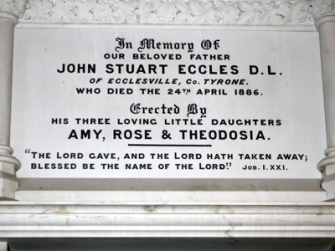
DEATH OF JOHN STUART ECCLES. ESQ. D.L. OF ECCLESVILLE, FlNTONA.
After a lapse of nearly seventeen years it again becomes our painful duty to write another obituary of a Master of Ecclesville. JohnStuart Eccles Esq. D.L. after a short but painful illness died at his late residence. Ecclesville House, on Saturday morning last, at the early age of thirty eight years past. About five weeks ago, deceased, who had been in delicate health for some time previous, was prost rated by an attack of acute inflammation of the liver, complicated with jaundice, and was, in the early stage of the disease, attended by Dr Thomas Duncan of Fintona, the family physician. The case developed grave symptoms shortly after, and Dr E C Thompson, of Omagh, and Dr Corley of Dublin, were summoned Ecclesville to meet the family physician in consultation; but, notwithstanding all that the highest medical skill could accomplish, the disease ended fatally on saturday morning last. Although from the first the most serious results were apprehended by his family and friends, yet it was not expected that death was so near, and to those outside who only knew vaguely his indisposition, the announcement came as painful surprise; especially to his tenantry and dependents. For generations the family has been respected, esteemed, and beloved those who were fortunate enough occupy the Ecclesville property where rights were respected, independence encouraged, the rental moderate, and the tenantry treated justly, courteously, and friendly. Deceased's father was almost idolized by every person on estate, and when death summoned, him away, the loss was felt acutely, and his people sorrowed for him for one of their own kindred. No less respected and beloved was his too, the deceased, although not come into such close relations with his people, but they knew him for a courteous gentleman, possessing a kindly heart, and earnest desire for their prosperity and happiness, who had always for them a warm shake of the hand and kindly smile wherever he met them. Deceased attained his majority the 9th October 1868 and was presented on the eventful occasion with an address and presentation of plate from the people of the Ecclesville property. His father died the 4th November, the year following, and he thus succeeded to the cares and management of the estate at an early age. He married on the 23rd May 1871, Francis Caroline, second daughter the late Thomas R Browne, Esq, D.L. Aughentaine Castle, whom, with her three young daughters, leaves behind to mourn his loss. Saturday one oclock was the day and hour fixed for the interment, which took place the family burying ground. where sleep generations the family. At the hour named a large number of the people of the town and neighbourhood, the tenantry on the estate, and a large number of gentlemen from Omagh, had assembled to pay the last tribute respect to deceased. Shortly after one clock, the coffin, covered with wreaths of immortelles was borne from Ecclesville Hall on the shoulders of the following gentlemen C W Lecky-Browne Lecky, Esq; Charles Eccles, I Esq, Dublin; (cousin deceased.) Major Hervey Knox Browne, D.L; Conolly M Gage, Esq.; Dr E C Thompson, Omagh; Cecil H Browne. Esq. J.P ; and Dr Duncan. Those gentlemen were also the last to carry it from the graveyard gate to the grave.
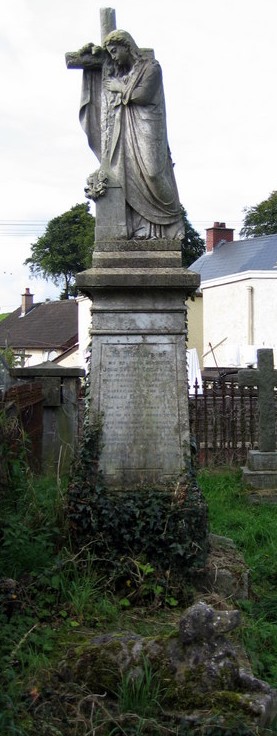
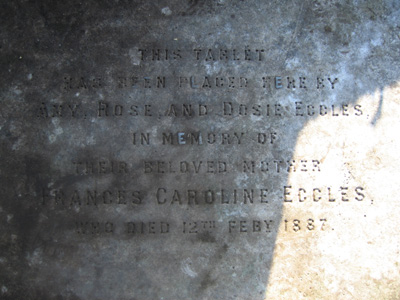
Grave of John Stuart Eccles and his wife Frances Caroline Browne at Castletown graveyard, Fintona.
The Later Eccles Generations and the McClintock Marriage
John Stuart Eccles, of Ecclesville, County Tyrone, married Frances Caroline Browne in 1871. She was the daughter of Thomas Richardson Browne and Sarah de Montmorency of Aughentaine Castle, Co. Tyrone. The couple had four children:
-
Charles Raymond Eccles (b. 22 August 1872 – d. 4 September 1872), who died in infancy.
-
Amy Henrietta Frances Eccles, later heir to Ecclesville for life.
-
Rose Isabella [or Isabel] de Montmorency Eccles (b. 5 January 1876).
-
Annie [or Anna] Theodosia Hester Eccles (b. 8 February 1878).
John Stuart Eccles died on 24 April 1886. His will, dated 1 October 1873, entailed the Ecclesville Estate in tail male, thereby restricting its inheritance to male heirs. He appointed his wife Frances as sole Executrix. A codicil dated 2 April 1886 named two additional Executors and Guardians for his minor children: Dr. Edward Charles Thompson of Omagh (his maternal cousin) and Dr. Thomas Duncan of Fintona.
Frances Eccles survived her husband by less than a year, dying on 12 February 1887. Her will, dated 8 February 1887, appointed her brother Conolly William Lecky Browne-Lecky, who was married to her late husband’s sister Annie Henrietta Eccles, as an additional trustee and guardian alongside Drs. Thompson and Duncan.
Conolly and Annie Browne-Lecky had two children of their own:
-
Isabella Caroline Anna [Annie] Browne-Lecky (b. 21 September 1879 – d. 1956), who married Charles Ernest William Bland of Colsterworth House, Lincolnshire.
-
Raymond Saville Conolly de Montmorency Lecky (b. 17 May 1881 – d. 11 November 1961), who died without issue.
Following the deaths of both their parents, Amy, Rose, and Annie Eccles were raised by their uncle and aunt, Conolly and Annie Browne-Lecky, as part of the Browne-Lecky household at Ecclesville and Fintimara, Warrenpoint, County Down. They were treated as members of the family, and their upbringing was overseen within a stable and well-connected landed household.
On 27 April 1893, Amy Henrietta Frances Eccles married John Knox McClintock of Seskinore, Co. Tyrone, at St. Stephen’s Church, Dublin. The McClintock family estate of Seskinore bordered Ecclesville, making the match not only desirable from a social and familial perspective but also advantageous in consolidating local land and influence. The couple shared ancestry, and it was hoped their union would produce a male heir, securing the entailed interests of both estates.
At the time of their marriage, the Eccles holdings amounted to 9,227 acres, while the McClintock estate comprised 4,553 acres—together representing one of the most significant consolidated landholdings in County Tyrone. On 21 July 1898, Amy gave birth to their only child, a daughter:
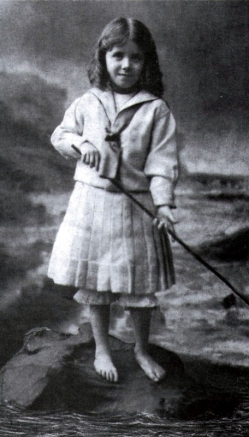
The Ecclesville Entail and Major J. K. McClintock’s 1903 Enquiry
After the death of John Stuart Eccles of Ecclesville on 24 April 1886, the Ecclesville Estate passed under the terms of his will dated 1 October 1873, which clearly entailed the estate in tail male. His widow, Frances Caroline Eccles (née Browne), daughter of Thomas Richardson Browne and Sarah de Montmorency of Aughentaine Castle, was named sole Executrix. A codicil dated 2 April 1886, just weeks before his death, appointed Dr. Edward Charles Thompson of Omagh (a maternal cousin) and Dr. Thomas Duncan of Fintona as additional executors and guardians for the children.
John Stuart Eccles and Frances Caroline Browne had four children:
1. Charles Raymond Eccles (b. 22 August 1872 – d. 4 September 1872)
2. Amy Henrietta Frances Eccles (b. 22 April 1874 – d. 4 April 1942)
3. Rose Isabel de Montmorency Eccles (b. 5 January 1876)
4. Anna Theodosia Hester Eccles (b. 8 February 1878)
With the death of Charles Raymond in infancy, no male heir survived. Upon John Stuart Eccles’s death, Amy Eccles, as the eldest surviving daughter, became the life tenant and beneficial heiress of the Ecclesville Estate, though not its legal owner in fee due to the male entailment.
Following Frances Caroline Eccles’s death on 12 February 1887, her will dated 8 February 1887 appointed her brother Connolly William Lecky Browne-Lecky (husband of Annie Henrietta Eccles, sister of John Stuart Eccles), alongside the two Doctors, as guardian and trustee of the Eccles children. Thereafter, the three orphaned daughters—Amy, Rose, and Anna (known as Dosie)—were brought up by their aunt and uncle, Annie and Connolly Browne-Lecky, residing at Ecclesville and their secondary residence at Fintimara, Warrenpoint, County Down.
On 27 April 1893, Amy Henrietta Frances Eccles married John Knox McClintock of Seskinore, a neighboring estate. The match was considered ideal: the families were socially and geographically aligned, shared ancestry, and the unification of the Eccles and McClintock estates offered strategic advantages. The Eccles estate then encompassed 9,227 acres, while the McClintocks held 4,553 acres.
In 1898, the couple had a daughter, Amelia Isobel Eccles McClintock (Leila), born 21 July 1898. However, the lack of a male heir triggered uncertainty regarding the succession of the entailed Ecclesville property.
Major McClintock’s Letter Requesting Legal Clarification (13 January 1903)
Faced with growing concerns about the inheritance of the Ecclesville Estate, Major J. K. McClintock sought formal legal clarification. On 13 January 1903, from Omagh, County Tyrone, he wrote to his solicitors, King Houston, requesting details on the operation of the entail under his late father-in-law’s will. The reply, a significant historical record, outlined the succession plan for the Ecclesville Estate under the male entail:
13th January 1903
Omagh, Co. Tyrone
Ecclesville Estate
Dear Sir,
In reply to your letter of 10th inst.,
The Ecclesville Estate goes as follows:
If Mrs. McClintock (Amy Eccles) dies without a son, the estate goes to Miss Eccles (Rose), if alive, for her life.
If she dies without a son, it will then go to Mrs. Stoney (Dosie), if alive, for life.
If she dies without a son, it will go to the eldest son (if any) of the late Charles Edward Eccles.
If he has died without a son, it will go to Robert Gilbert Eccles (grand-uncle), if alive, for his life, and after his death, to his eldest son.
Failing all this, it will go in thirds to the daughters of Mrs. McClintock, Miss Eccles, and Mrs. Stoney.
If Miss Eccles should die without children, then one half to the daughters of Mrs. McClintock, and one half to the daughters of Mrs. Stoney.
Under the settlement of the Ecclesville Estate executed upon your marriage, in case Mrs. McClintock dies without a son, your daughter will only receive £3,000 out of the entire estate.
Seskinore Estate:
Upon your death, the estate goes to your daughter, provided there is no son.
Yours faithfully,
King Houston
Major J.K. McClintock, Seskinore
Legal and Family Implications
The letter made it clear that while Amy Henrietta Frances Eccles McClintock was life tenant and beneficial heir, she was not the legal owner of the estate beyond her own life unless she produced a male heir. Without a surviving son, the entailed heir under the 1873 will of John Stuart Eccles would be Anthony Charles Stuart Delmege, the eldest son of Rose Isabel Eccles (Amy’s sister), who had married Captain Carfrae Hamilton Delmege.
Thus, despite Amy's position as heiress apparent, the legal title was destined to pass through the male line, according to the will’s entail. The £3,000 provision for her daughter Leila was minimal compared to the value and scale of the Ecclesville Estate, underscoring the legal weight of primogeniture and strict settlements in landed Irish gentry families of the 19th century.
Amelia (Leila) Isobel Eccles McClintock.
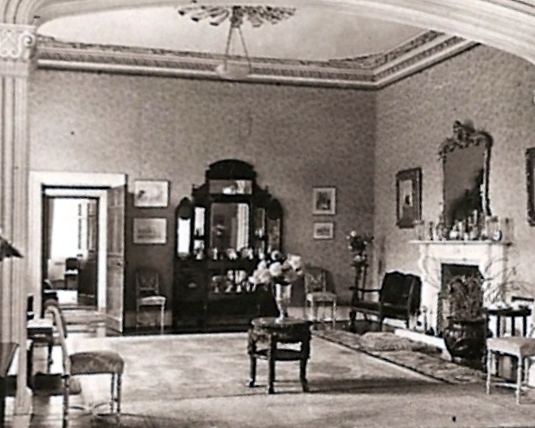
Drawing room, Ecclesville House.

Amy Henrietta Frances Eccles (Above)
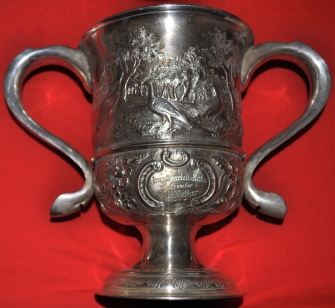
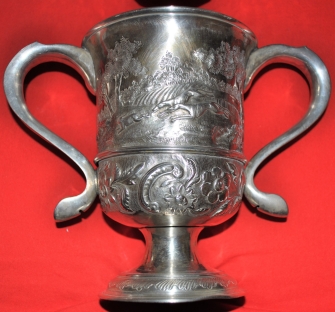
Jemima Eccles, nee Dickson d. 19th April 1879, (3rd dau of Thomas Dickson, of Woodville, Co. Leitrim) presented the above cup to Amy Eccles her G Grandaughter, it is inscribed:
To Amy Henrietta Eccles
From her G G mother
On the Anniversary of her birthday, 22nd April 1875.
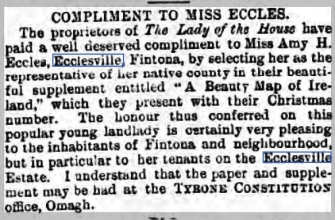
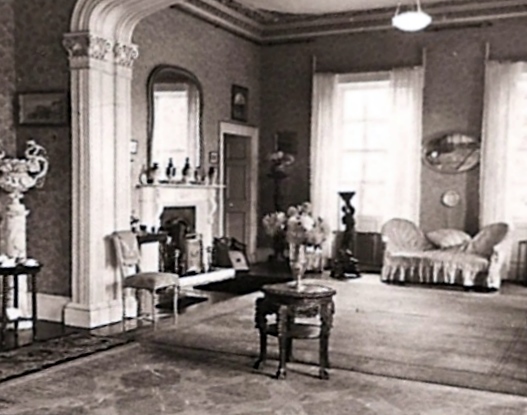
Drawing room, Ecclesville House.
Tyrone Constitution, 16th Dec 1892.
The Ecclesville Estate and the Irish Land Acts
During the tenure of Mrs. Amy Henrietta Frances McClintock (née Eccles) as landlady and beneficial owner for life of the Ecclesville Estate, sweeping land reforms under the Irish Land Acts enabled tenants across Ireland to purchase the lands they occupied from their landlords. As a result, Mrs. McClintock sold the greater portion of the Ecclesville Estate to tenant purchasers, retaining the Ecclesville demesne and mansion house, comprising 206 acres, 1 rood, and 20 perches.
Later, she sold the demesne and parts of the remaining lands to her Browne-Lecky relatives, with Raymond Browne-Lecky ultimately becoming the final owner of Ecclesville—a property that had remained in the family for nearly three centuries.
Abstract of Title – Ecclesville Estate
Irish Land Commission Record No. EC6974 – Estate of Mrs. Amy H. McClintock, County Tyrone
In 1913, the title to the Ecclesville Estate was formally submitted to the Irish Land Commission, described at the time of its disposal to the tenantry as follows:
(A comparison table of the acreages of the Balliboes/townlands can be seen in this link from 1840-1913), and described as follows at the time of the disposal to the tenantry :-
The Ecclesville Estate in the County of Tyrone comprising
All that and those the lands of Fintonagh otherwise Ra(th)keeran otherwise Castleleigh with the appurtenances and All that and those the Town and lands of, Fintonagh otherwise Rathkeeran otherwise Castleleigh one Balliboe, Finan otherwise Courmere one Balliboe, Loggetigill otherwise Leggetigill one Balliboe, Benenamullen otherwise Mullen one Balliboe, Killelessie otherwise Killissie otherwise Killalissie one Balliboe, Tonagheitra one Balliboe, Straghduffegower one Balliboe, Garrewery otherwise Garwary one Balliboe, Ballinaskelgie otherwise Skelgagh one ballyboe, Donaghgoran otherwise Dungoran one Balliboe, Edentoodery otherwise Edentoudery one Balliboe, Lackaboy one Balliboe, Tonegrenane otherwise Tyrenane one Balliboe, Toneghenan otherwise Tonagh one Balliboe, Syonhugh otherwise Syoney one Balliboe, Tullyrush one Balliboe, Carcorbally one Balliboe, Drumheruck otherwise Drumhurke one Balliboe, Straguraskie otherwise Straniske one balliboe, Mullasilloge one Balliboe, Kilberry one Balliboe, Drumlaghan one Balliboe, Shreaggagourie one Balliboe, Derryaghnan otherwise Draghton one Balliboe Mullinadrummon otherwise Ballynadrummon otherwise Mornblanedrummon otherwise Clonedrummon otherwise Uriblanedrummon one Balliboe, Arditony one Balliboe, Aghibrassil one Balliboe, Townaghoane one Balliboe, Rowarran one Balliboe, Edinesope one Balliboe, Lisgardeffe otherwise Lisnagardy one Balliboe, Taticriby otherwise Tatecrivey otherwise Lisnacrivey one Balliboe, Gardrum one Balliboe, Tatterfadda otherwise Tattafadda otherwise Tatafadi otherwise Aghafad one Balliboe, the town and lands of Strabane, Lorganbay, Coragh and Liscomie being subdenominations of Correseston otherwise Corriskshe one Balliboe, Corglass one Balliboe, and Tatemoyle one Balliboe the town and lands of Anaghrunane, Annaghmurragh, Anaghbow, Carnarouske, Goldaldrew, Laccam Lisnabubary, Lissdergan, Lissavaddy, Legaimaghry, Liskey, Mullans otherwise Roghan, Sionfin and Scrigagh with the appurtenances and which said several towns land tenements hereditaments and premises are known & commonly called by the several names.
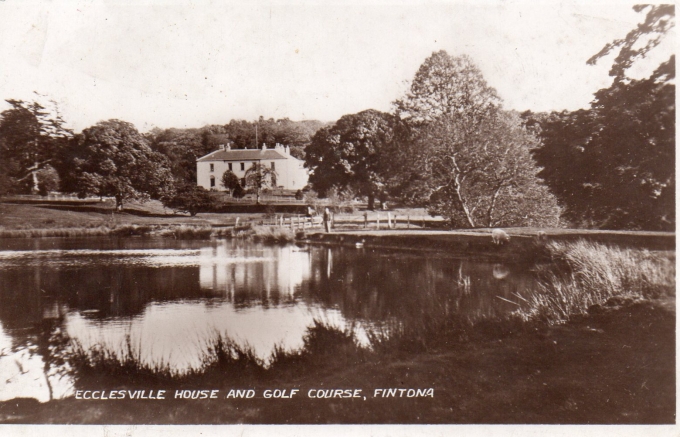
Later Years of Ecclesville House: From McClintocks to Browne-Leckys
Amy Henrietta Frances McClintock (née Eccles) and her husband Captain John Knox McClintock resided at Ecclesville House until around 1899, when they relocated to Seskinore House. Around this time, Colonel H.G.S. (“Harry”) Alexander, Jack McClintock’s uncle and agent of the Seskinore Estate, moved into Ecclesville House and assumed management of the Ecclesville Estate.
The Alexanders later left Ecclesville and returned to Harry’s family residence at Carrickmore House, Termon.
Around 1909, Amy’s maternal uncle, Conolly William Lecky-Browne-Lecky, and her paternal aunt, Annie Browne-Lecky (née Eccles), moved into Ecclesville. They purchased the Ecclesville demesne under the terms of the Irish Land Commission, acquiring the mansion house and its surrounding 206 acres, 1 rood, and 20 perches.
The Browne-Leckys divided their time between Ecclesville and their home Fintimara, in Rostrevor, County Down. In 1915, Conolly advertised Fintimara for lease or sale, and it was ultimately sold around 1919.
They also spent time in Dublin, Portrush, Rostrevor/Warrenpoint, and on the Continent, wintering in more temperate climates. Their son, Raymond Browne-Lecky, was an accomplished actor and musician, frequently performing at "at homes" gatherings hosted by his mother. A private theatre was built in the west wing of Ecclesville House, where Raymond produced and staged numerous plays. He took these productions on tour throughout Ireland, often in support of charitable causes.
Conolly William Lecky-Browne-Lecky died on 12 January 1924, and Raymond inherited Ecclesville, becoming its final private owner before the estate left the family’s hands.
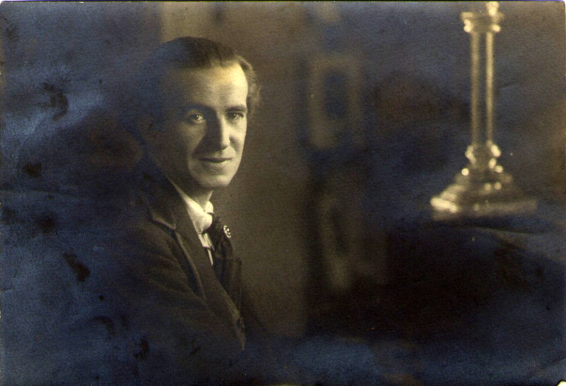
Above; Raymond Saville Conolly de Montmorency Lecky Browne-Lecky
of Ecclesville.
Scandal and Exile: The Fall of Amy Eccles McClintock
Around 1916, during the First World War, Colonel John Knox McClintock, although past the age for front-line service, was serving as commander of the 3rd Battalion, Royal Inniskilling Fusiliers at Londonderry. It was during this period that troubling news reached him: his wife, Amy Henrietta Frances McClintock (née Eccles), was reportedly engaged in an affair with a man from Omagh.
Determined to confront the situation directly, the Colonel returned unexpectedly to Ecclesville. According to villagers who recounted the story as late as 2005, he caught the couple “in the throngs of passion”. In a fit of rage, he burst into the room and chased the naked man from the house with a horsewhip—a moment that quickly became the stuff of local legend.
This dramatic story was later verified by Rosalie McClintock (née Orr), daughter of W.E. Orr, Clerk of the Crown and Peace, and a close friend of the Colonel. Rosalie identified the man as George Fleming, son of Dr. Fleming of Campsie House, Omagh. She recalled that the Colonel had threatened to shoot Fleming on the spot, and she believed he would have been justified in doing so.
Following this scandal, Colonel McClintock banished Amy from Ecclesville. She was ostracised from the McClintock family circle and excluded from all social functions and family life. Forced into exile, Amy left Ireland and settled in England, initially near her sister Dosie in Gloucestershire. It is said she never returned to Ireland for the remainder of her husband’s lifetime.
The timeline is consistent with archival records: on 27 November 1917, Amy’s daughter Leila McClintock enrolled in the Royal Flying Corps (RFC) at Rendcomb, Gloucestershire. This aligns with the family’s relocation following the marriage breakdown.
Later, Amy moved to Molstyn, Orestan Lane, Effingham, Surrey, where she lived near her niece Rose Sugden (née Dorman) and Rose’s husband, William Frank Sugden.
Amy died on 4 April 1942 and was buried in a simple grave at St. Lawrence Churchyard, Effingham. Her beloved sister Dosie, with whom she had remained close throughout her exile, died many years later on 8 July 1960, and was buried in the same grave, bringing the two sisters together once more.
WELL - KNOWN TYRONE FAMILIES BEREAVED.
Several well-known County Tyrone families have
been bereaved by the death, which has occurred
suddenly at Effingham, Surrey, of Mrs. Amy H.
McClintock, widow of the late Colonel J. K.
McClintock, C.B.E. D.L., Seskinore, County Tyrone,
and eldest daughter of the late
Mr. John Stuart Eccles, D.L., of Ecclesville, Fintona.
Londonderry Sentinel - Thursday 16 April 1942
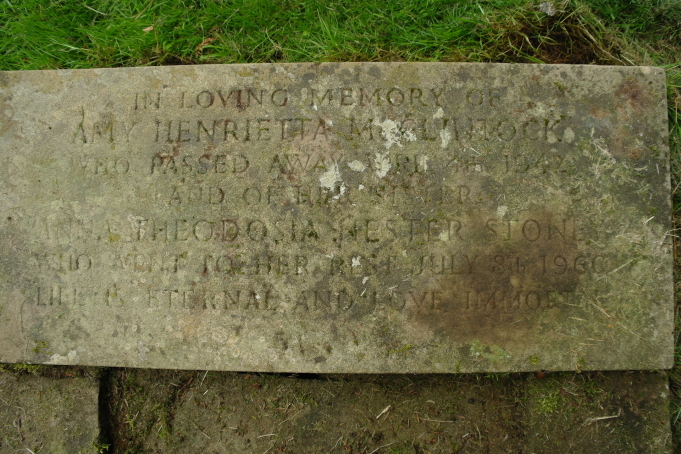
IN LOVING MEMORY OF
AMY HENRIETTA MCCLINTOCK
WHO PASSED AWAY APRIL 4TH 1942
AND OF HER SISTER
ANNA THEODOSIA HESTER STONEY
WHO WENT TO HER REST JULY 8TH 1960
LIFE IS ETERNAL AND LOVE IMMORTAL
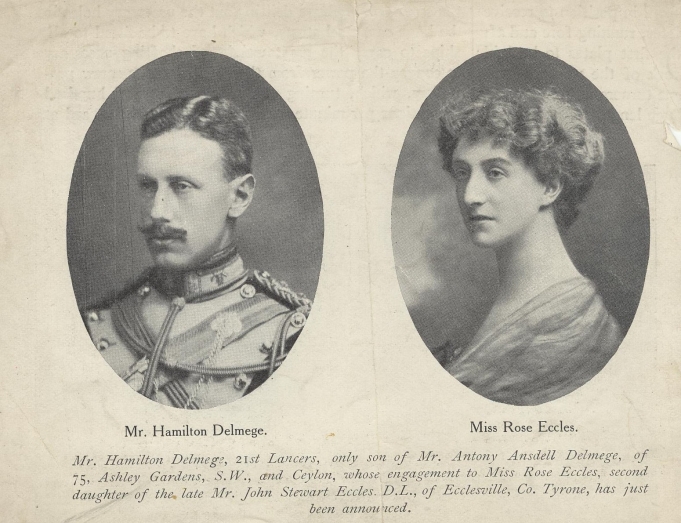
The Delmege Inheritance: Ecclesville Estate and Cricklade Manor
Under the terms of John Stuart Eccles’ will, what remained of the Ecclesville Estate was entailed in tail male to the first male heir descended from his daughters, in order of seniority. Although Rose Eccles was not the eldest daughter, her son, Anthony Charles Stuart Delmege, proved to be the first male descendant in that line and thus inherited under the entail. Rose had married Major Carfrae Hamilton Delmege (1880–1945) of Rathkeale, County Limerick, in 1906.
The following information (and photograph) about the Delmege family can be found at the Cricklade Museum, established by the Cricklade Historical Society:
*"The Delmeges purchased Cricklade Manor, Wiltshire, c.1920, which they extended about the same time. Rose died on 8 May 1929.
The Delmeges were an Irish family who settled in Cricklade when it became impossible for the Major and his wife to retire to India. They had two sons, Jim and Tony, and a daughter, Sheilah.
The family are still remembered affectionately by local people, although they were more reclusive than the Butt Millers, and their domestic help was greatly reduced. Three sisters of a local family, the Vincents, were their governess, housekeeper, and lady’s maid.
Mrs. Delmege was the first president of the Cricklade Women’s Institute when it was founded in 1922, and also of the Ladies' Tennis Club.
Eileen Edwards remembers that one of the sons contracted tuberculosis as a youth. When she and her friends played on Pauls Croft field, they were fascinated to see him lying in bed under a canvas shelter in the Manor House garden — a common treatment for convalescents at the time.
Son Jim attended Cirencester Agricultural College, where he was master of the beagle hound pack.
As an adult, Sheilah (Sheelagh) Delmege performed the opening ceremony of the present Town Hall in 1933, but the occasion best remembered is her wedding to a Major John Wilder in the same decade.
May New recalls an awning and red carpet which stretched all the way from St. Sampson’s Church to Bath Road, and Dot Kilminster the delphiniums gathered from local gardens to decorate the church.
Tragically, the honeymoon was cut short when the groom died from an infection caused by the prick of a thorn."*
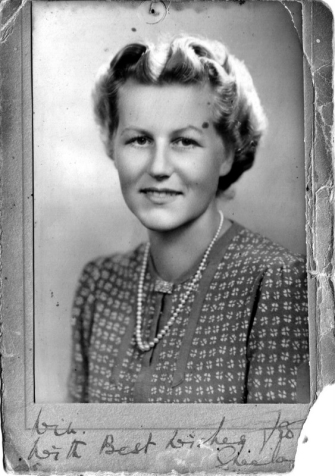
Sheelagh Edith delmege.
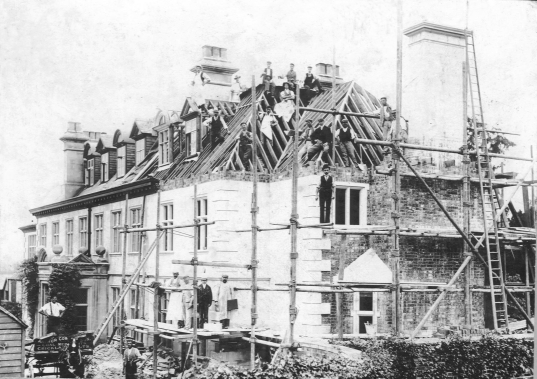
Cricklade manor, extension work being carried out for Major. Delmege. c.1920.
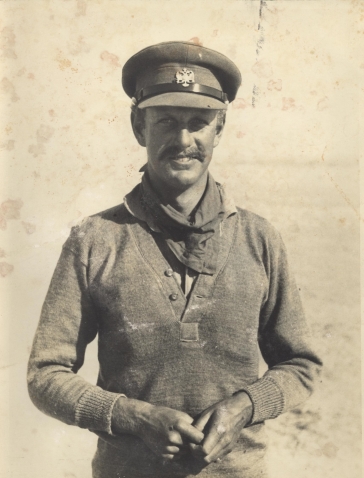

Colonel Anthony Charles Stuart Delmege (1910–1961)
Anthony Charles Stuart Delmege was born on 1 December 1910, the son of Major Carfrae Hamilton Delmege (1880–1945) of Rathkeale, County Limerick, and Rose Isabel de Montmorency Eccles — daughter of John Stuart Eccles of Ecclesville.
Although Rose was not the eldest daughter, her son Anthony became the first male heir through the daughters of John Stuart Eccles, and thus inherited what remained of the Ecclesville Estate under the entailed tail male provision in his grandfather’s will.
Anthony Delmege pursued a distinguished military career. He gained the rank of Colonel in the 1st King’s Dragoon Guards (Special Reserves) and served as Aide-de-Camp to the Governor of Madras, a prestigious colonial appointment reflecting his standing.
He remained unmarried and died on 22 July 1961, at the age of 50.
Colonel Delmege visited Ecclesville in 1951, a return to his ancestral estate, which was reported in The Londonderry Sentinel on 1 September 1951.
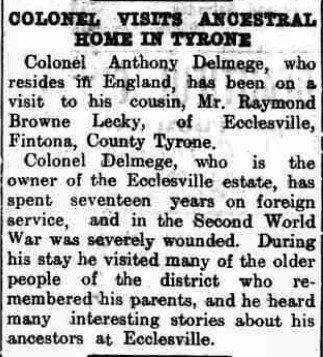
The Ecclesville Estate became vested in Anthony Charles Stuart Delmege. (below)
Registered in the registry of deeds Belfast
On 22 Feb 1944 book 3 No. 228
To the Registrar of Deeds in Northern Ireland.
A Memorial of an Indenture dated the Seventh day of February one thousand one hundred and forty-four Made between Anthony Charles Stuart Delmege of the Manor House, Cricklade in the County of Wilts a Major in His Majesty’s Army of The one part and Robert McLraith Blakeney of 25 Clare Street in the City of Dublin Solicitor of the other part. Whereby after reciting (inter alia) that under by virtue of the Will dated the first day of October one thousand eight hundred and seventy-three and a Codicil thereto dated the second day of April one thousand eight hundred and eighty six of John Stuart Eccles late of Ecclesville in the County of Tyrone who died on the twenty-fourth day of April one thousand eight hundred and eighty-six and which Will and Codicil were duly proved by Frances Caroline Eccles, Thomas Duncan and Edward C. Thompson the Executors and Executrix therein named in the District Registry of Armagh of the Probate and Matrimonial Division of the High Court of Justice in Ireland, the lands tenements and hereditaments described in the First Part of the Schedule thereto and thereto were settled and assured to uses under which the said Anthony Charles Stuart Delmege is tenant in tail male in possession thereof It Was Witnessed that the said Anthony Charles Stuart Delmege granted unto the said Robert McLraith Blakeney and his heirs All That And Those the lands rent and hereditaments comprised in and settled by the said Will except such part of same as had been disposed of by way of sale and also all other the freehold hereditaments of or to which the said Anthony Charles Stuart Delmege was then seised or entitled as tenant in tail male or in tail whether at law or in equity by virtue of the said Will or otherwise now-soever To Hold the same unto the said Robert McLraith Blakeney and his heirs freed and discharged from the estate in tail male or in tail of the said Anthony Charles Stuart Delmege at law or in equity and from all remainders reversions estates rights interests and powers to take effect after the determination or in defeasance of such estates tail to the use nevertheless of the said Anthony Charles Stuart Delmege in fee simple.
Schedule referred to in the said Indenture
First Part
All that and those part of the lands of Annaboe, Aughafad, Aughadreenan, Arditiney, Castletown, Corbally, Cumber, Carnarousk, Drafton, Drumlaghan, Drummond, Dundiven, Dungoran, Edenatoodry, Ecclesville, Edenasop, Feenan, Gulladoo, Gargrim, Killaliss, Killaberry, Lacca, Lisnacreive, Lisnabulravey, Lisdergan, Lisavaddy, Legamaghery, Lisnagardy, Legatiggle, Liskey, Mullans, and Roughan, Mullasligo, Rathwarren, Ratherane, Sionfin, Stratigore, Screggagh, Skelgagh, Stranisk, Sionee, Tattymoyle, Tonnaghmore, Tonnaghbeg, Tonnaghbane, Tullyrush and Tyreenan, Fintona, Castletown, Edenasop, Fintona Mill, Tonagh Mill, Lacca Mill and Fintona Market All of which are situate in the parish of Donacavey, Baronies of Clogher and East Omagh and Co. of Tyrone. And known as the Ecclesville Estate.
Second Part
|
£2020 |
41/2% land Bonds |
|
£4727.13.8 |
War Loan 31/1% |
|
£312.12.3 |
War Loan 31/2% |
|
£4.13.0 |
War Loan 31/2% |
|
£100.11.1 |
War Loan 31/2% |
|
£12071.11.4 |
21/2 Cousels |
|
£61.0.0 |
London Midland & Scottish Railway Company 4% |
|
£50.0.0 |
Great Southern railway Company (J) 4% Guaranteed Preference Stock |
|
£100.11.1 |
War Loan 31/2% |
Which said Deed and this memorial as to the execution thereof by the said Anthony Charles Stuart Delmege by Robert Wallace Hamilton under Power of Attorney is witnessed by G. Bradshaw, 25 Clare Street, Dublin, Spinster and Donald R Cullen, solicitor, 25 Clare Street, Dublin, and which said deed as to the execution thereof by the said Robert McLraith Blakeney is witnessed by Donald R. Cullen, Solicitor, 25 Clare, Street, Dublin.
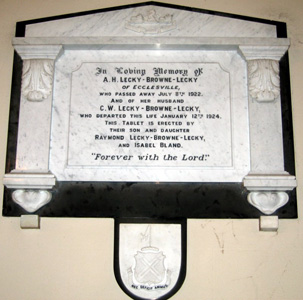
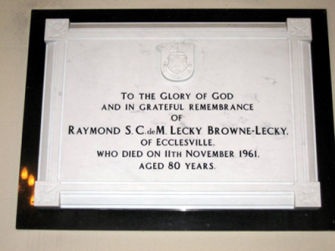
Death and Bequest of Raymond Browne-Lecky (1881–1961)
Raymond Browne-Lecky, last private owner of Ecclesville, died on 11th November 1961 — Remembrance Day — at the age of 80.
By the terms of his last will and testament, he bequeathed Ecclesville House and demesne to the Government of Northern Ireland, or such public body as the Government might designate, under the following condition:
“That my estate shall be indemnified or relieved from payment of any death duties on the said property and that the said property shall not be aggregated with the rest of my estate so as to increase the rate of duty on such estate.”
This generous act was intended to preserve the historic house and grounds for the public benefit. However, the remainder of the contents — comprising a treasure trove of antiques, paintings, silver, jewellery, and other heirlooms accumulated by the Eccles family over nearly 300 years — were not included in the donation.
These valuables were sold at a major auction held at Ecclesville House, conducted by John Ross & Co. of Belfast. The sale attracted collectors and dealers from around the world and achieved a then-record sum of £23,500, a substantial amount for the early 1960s.
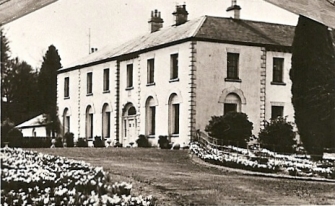
Gift Offer by Govt.
Gets Refused.
ECCLESVILLE, the 250 - year - old haunted mansion in Co. Tyrone willed to the Government by its late owner, may turn out to be a headache for the authorities. But the problem is not the lady-in-silk ghost who reputedly flits from room to room. The big question is: What will the Government do with the house? This week the Ministry of Health and Local Government inquired if Tyrone Welfare Committee was interested in it for possible use as an old people's home. But the Committee decided it didn't want to be burdened with the upkeep of an old mansion and said "No, thank you." Said a Ministry of Finance spokesman: "We will have to see if anyone else is interested." When he died last November 80-year-old bachelor. Mr. Raymond de M. Browne-Lecky, directed in his will that his land and mansion house at Fintona should be handed over to the Government or whatever public body the Government should nominate. But even though the Ministry offered the mansion to Tyrone Welfare Committee it seems that the Government doesn't actually own the mansion yet. Said the solicitors handling the estate: Ecclesville was willed to the Government for whatever purpose it could And—on certain conditions the Government had to comply with. The Ministry has given us no official Intimation that it has accepted it yet. "Mr. Browne-Lecky had no family of his own and he possibly thought the Government might turn the place into an old people's home or something like that." But nowadays Tyrone Welfare Committee prefers to build new homes. "We are not anxious to take any more old buildings over and convert them," said Mr. A. P. Fields, County Welfare Officer. "We were compelled to do that sort of thing in the early days when building was difficult. We took over one or two old houses, but there are repairs and upkeep to be considered. Nowadays we start from scratch. Anyway we have an old people's home at Clogher, 10 miles away, and we have a new one opening in Omagh this autumn." And so, for the present, the phantom in silk has Ecclesville to herself.
Belfast Telegraph - Friday 23 February 1962
Despite the intentions expressed in Raymond Browne-Lecky's will, the Government of Northern Ireland was ultimately unable to find a viable public use for Ecclesville House. In the years following the bequest, the property was advertised to let, but no enduring tenancy or institutional purpose materialised.
After a period of consideration, it was determined that the property was surplus to requirements. Consequently, a notice of application to demolish the house was formally published in The Belfast Gazette on 1st January 1978.
This marked the end of Ecclesville House as a private and public residence, concluding over two and a half centuries of continuous occupation and stewardship by the Eccles family and their descendants.
Mansion House.
Fintona
TO LET UNFURNISHED on long or
short Lease with approximately 3 1/2
Acres. Accommodation includes:
Spacious Living-room, Library. 8
Bedrooms. Usual Offices. Mains Water
and Electricity. Extensive Servants'
quarters include 4 Bedrooms. Ample
Store Rooms. Outhouses and Garage
Accommodation.
Lessee be responsible Rates
and maintenance. (P. L. V. of house
£100).
For further particulars and arrange-
ments to view apply to:
The Secretary. Ministry of Agriculture.
27 Upper Queen Street BELFAST. 1.
With whom sealed Tenders should be
Lodged not later than 27th AUGUST.
1962.
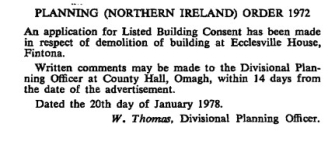
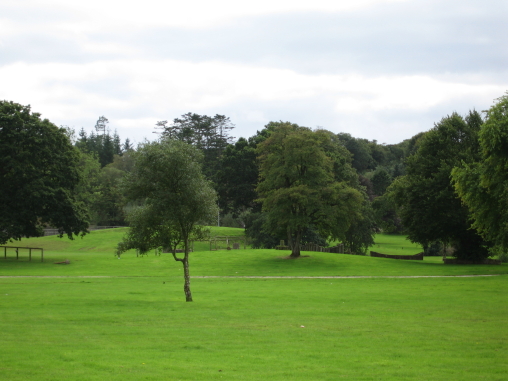
The site of Ecclesville House.
